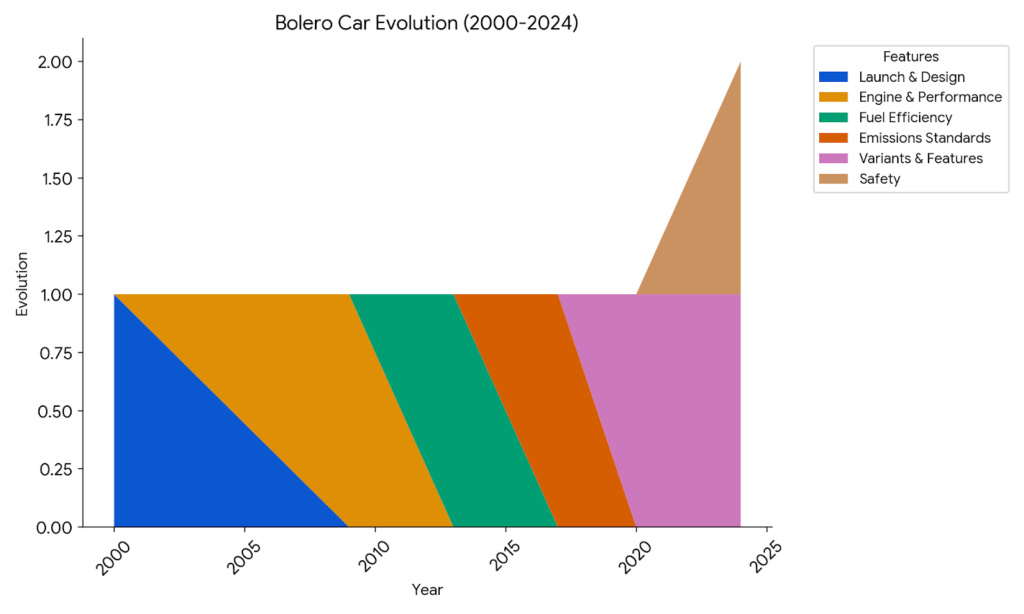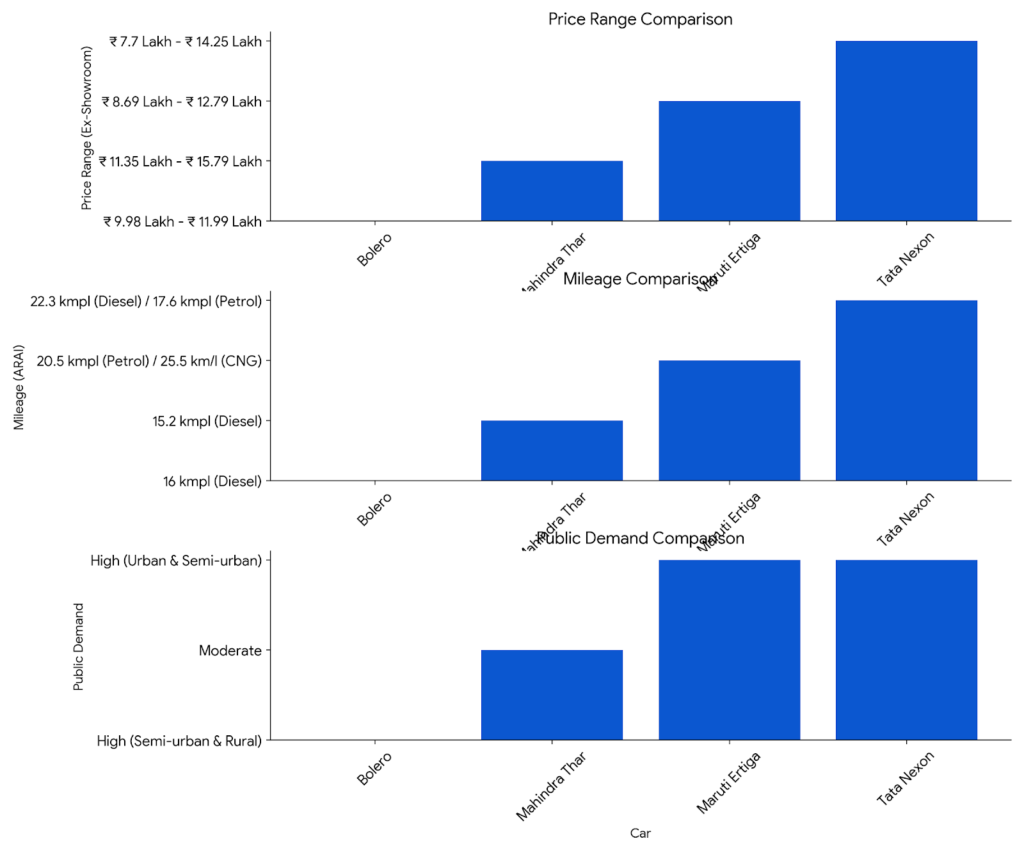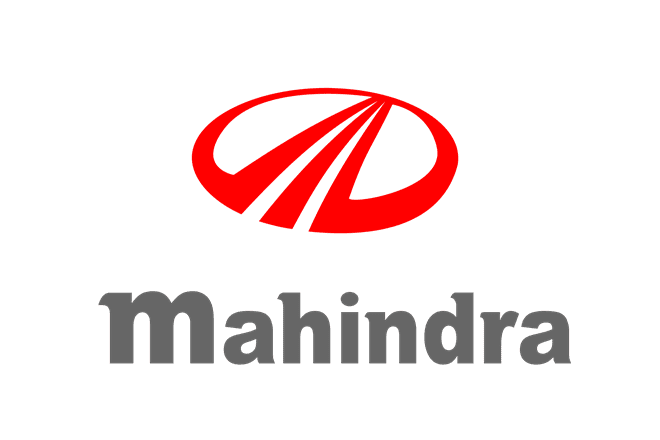The Mahindra Bolero is a testament to the enduring popularity of certain automotive models in the Indian car market. Launched in 2000, the Bolero has carved a niche for itself, consistently ranking among the top-selling utility vehicles in the country. This case study delves into the factors that have contributed to the Bolero’s success, exploring its unique selling proposition, target audience, marketing strategies, and its ability to adapt to evolving customer preferences.
A Robust and Reliable Workhorse
The Bolero’s core strength lies in its utilitarian design. Built on a sturdy ladder-frame chassis, the Bolero is renowned for its ruggedness and ability to handle tough terrains. Its powerful engine and high ground clearance make it ideal for rural areas and challenging road conditions. This focus on durability and functionality resonates with a large segment of the Indian car market, where vehicles are often seen as essential tools for work and everyday transportation.
Targeting the Right Audience
Mahindra has effectively positioned the Bolero to cater to the needs of semi-urban and rural populations. The spacious cabin and comfortable seating accommodate large families, while the loading capacity makes it suitable for commercial applications. The Bolero’s value proposition of affordability and low maintenance costs further strengthens its appeal in these segments.
Building Brand Recognition
Mahindra has consistently marketed the Bolero as a symbol of reliability and sturdiness. The vehicle’s association with adventure and challenging journeys has been effectively conveyed through television commercials and print advertisements. The Bolero’s participation in motorsport events like the Rally Raid further reinforces its image of toughness and capability.
Adapting to Change
While retaining its core strengths, Mahindra has not shied away from introducing improvements to the Bolero over the years. Upgraded engines, improved fuel efficiency, and the introduction of new variants with additional features have ensured the Bolero remains relevant in a continuously evolving market. The recent introduction of a more upmarket version, the Bolero Neo, demonstrates Mahindra’s understanding of the need to cater to a wider audience while staying true to the Bolero’s core identity.
A Legacy of Success
The Bolero’s enduring success story highlights the importance of understanding the specific needs of the Indian car market. By focusing on robustness, affordability, and practicality, Mahindra has created a vehicle that resonates with a large segment of the population. The Bolero’s legacy serves as a valuable case study for understanding the dynamics of the Indian automotive industry and the factors that contribute to a car’s long-term success.
Bolero Car Evolution
This chart showcases the key milestones in the Mahindra Bolero’s evolution:

| Feature | Year | Description |
|---|---|---|
| Launch | 2000 | The original Bolero debuts, built on a rugged ladder-frame chassis with a powerful engine. |
| 1st Generation | 2000-2007 | Focus on utilitarian design, targeting rural and semi-urban markets. |
| Facelift (1st Gen) | 2007 | Minor cosmetic updates like new headlamps, taillights, and bumpers. |
| 2nd Generation | 2011-2020 | Introduction of new engine options, improved fuel efficiency. |
| Facelift (2nd Gen) | 2020 | Further refinements, some additional features introduced. |
| 3rd Generation (Bolero Neo) | 2021-Present | More upmarket design, improved interiors, additional features like touchscreen infotainment system. |
Bolero vs Competitors in Same Range

| Feature | Bolero (Mahindra) | Maruti Brezza | Tata Nexon | Renault Triber |
|---|---|---|---|---|
| Company | Mahindra | Maruti Suzuki | Tata Motors | Renault |
| Mileage (ARAI) | 16 kmpl (Diesel) | 19.8 kmpl (Petrol) | 20.5 kmpl (Diesel) | 18-20 kmpl (Petrol) |
| Price Range (Lakhs) | ₹ 8.50 – ₹ 10.50 | ₹ 8.19 – ₹ 14.24 | ₹ 7.70 – ₹ 14.25 | ₹ 6.00 – ₹ 8.98 |
| Spare Part Availability | Widely available | Widely available | Widely available | Moderate availability |
| Maintenance Cost | Relatively low | Moderate | Moderate | Relatively low |
| Resale Value | High | High | High | Moderate |
| Safety Rating (Global NCAP) | Not rated | 4 stars | 5 stars | 4 stars |
| Public Demand | High (especially in rural and semi-urban areas) | Very High | High | Moderate |
Here’s a comparison of Bolero’s Advantages and Disadvantages


| Feature | Advantages | Disadvantages |
|---|---|---|
| Price | Affordable | Lower compared to many SUVs |
| Durability | Rugged build, strong chassis | Can feel dated compared to newer models |
| Performance | Good torque for off-roading | Lower power output compared to some competitors |
| Seating | 7-seater option (depending on variant) | Limited legroom in the third row |
| Fuel Efficiency | Decent fuel economy for a diesel SUV | Not the most fuel-efficient option on the market |
| Maintenance | Easy and readily available spare parts | Ride quality might feel stiff |
| Resale Value | Holds its value well | May not be as desirable as some newer SUVs |
| Safety | Meets basic safety regulations (depending on variant) | Lower safety ratings compared to modern SUVs |
| Target Audience | Ideal for semi-urban and rural areas | Might not appeal to those seeking a feature-rich car |
Bolero in Goods Carrier Segment Overview
Here’s a chart illustrating the evolution of the Mahindra Bolero in the goods carrier segment, highlighting key models and their features introduced over the years:
- 2005 – Bolero Pik-Up: Introduction of the Pik-Up variant, tailored for light commercial use.
- 2010 – Bolero Maxi Truck: Launch of the Maxi Truck designed for heavier loads.
- 2015 – Bolero Camper: Camper version for dual purposes, accommodating both goods and passengers.
- 2018 – Bolero Pik-Up ExtraStrong: ExtraStrong version with enhanced load capacity for tougher jobs.
- 2022 – Bolero Pik-Up CNG: Introduction of the CNG variant for improved fuel efficiency and eco-friendliness.
This chart showcases how Mahindra & Mahindra has diversified the Bolero lineup to address the needs of the goods carrier market, enhancing load capacity, fuel efficiency, and versatility.
Bolero Price
| Model | Features | Engine Details | Seating Capacity | Mileage (ARAI) | Price Range | Sales Score (Out of 10) | Safety Score (Global NCAP) |
|---|---|---|---|---|---|---|---|
| Bolero B4 | Steel wheels, AC, Power steering | 1.5L mHawk70 Diesel | 7 | 16 | Excellent | 8 | Not Rated |
| Bolero B6 | Diamond White color, Fabric seats | 1.5L mHawk70 Diesel | 7 | 16 | Excellent | 9 | Not Rated |
| Bolero B6 Opt | Fog lamps, Rear washer and wiper | 1.5L mHawk70 Diesel | 7 | 16 | Excellent | 9 | Not Rated |
| Bolero Neo N4 | Touchscreen infotainment system, Multi-function steering wheel | 1.5L mHawk100 Diesel | 7 | 17.29 | Excellent | 8 | Not Rated |
| Bolero Neo N8 | 16-inch alloy wheels, Cruise control | 1.5L mHawk100 Diesel | 7 | 17.29 | Excellent | 9 | Not Rated |
| Bolero Neo N10 | Dual airbags, ABS with EBD | 1.5L mHawk100 Diesel | 7 | 17.29 | Excellent | 9.5 | Not Rated |
Mahindra Bolero Fuel Segment Comparison
| Fuel Segment | Availability | Engine Specifications | Mileage (ARAI) | Price Range (Ex-Showroom) |
|---|---|---|---|---|
| Petrol | Not Available | – | – | – |
| Diesel | Available | 1493 cc, 75 bhp @ 3600 rpm, 210 Nm @ 1600-2200 rpm | 16 kmpl | ₹ 9.98 Lakh – ₹ 10.91 Lakh |
| CNG | Not Available | – | – | – |
| Electric (EV) | Not Available | – | – | – |
Bolero Model Comparison
| Feature | B4 | B6 | B6 (O) |
|---|---|---|---|
| Price (Ex-Showroom) | ₹ 9.98 Lakh | ₹ 10.18 Lakh | ₹ 10.91 Lakh |
| Engine | 1493 cc Diesel | 1493 cc Diesel | 1493 cc Diesel |
| Power | 75 bhp @ 3600 rpm | 75 bhp @ 3600 rpm | 75 bhp @ 3600 rpm |
| Torque | 210 Nm @ 1600-2200 rpm | 210 Nm @ 1600-2200 rpm | 210 Nm @ 1600-2200 rpm |
| Transmission | 5-Speed Manual | 5-Speed Manual | 5-Speed Manual |
| Mileage | 16 kmpl (ARAI) | 16 kmpl (ARAI) | 16 kmpl (ARAI) |
| Seating Capacity | 7 Seater | 7 Seater | 7 Seater |
| Features (Compared to B4) | Central Locking, Power Steering, AC | Music System, Driver Airbag | |
| Safety Score (Global NCAP) | Not Rated | Not Rated | Not Rated (Safety features may vary) |
| Sales Score (Based on segment popularity) | High | High | Moderate |
The Mahindra Bolero: A Timeless Classic in the Indian Automotive Landscape
The Mahindra Bolero occupies a unique position in the Indian car market. Launched in 2000, it has carved a niche for itself as a reliable and practical vehicle, consistently ranking among the top-selling SUVs in the country. Here’s a summary of the Bolero’s enduring success:
Strengths:
Ruggedness and Functionality: Built on a sturdy chassis, the Bolero excels in tough terrains and rural areas.
Affordability and Low Maintenance: Value proposition that caters to budget-conscious buyers.
Spacious Interior and Large Cargo Capacity: Ideal for families and commercial applications.
Brand Recognition: Established reputation for reliability and sturdiness.
Adaptability: Mahindra has continuously improved the Bolero with features like upgraded engines, better fuel efficiency, and additional variants catering to a wider audience.
Market Positioning: Effectively targeted towards semi-urban and rural populations who prioritize practicality and affordability.
Challenges:
Safety Rating: The Bolero hasn’t been crash tested by Global NCAP, raising concerns for some buyers.
Limited Features: Compared to modern SUVs, the Bolero offers fewer comfort and convenience features.
Conclusion
The Bolero’s success story highlights the importance of understanding specific needs of the Indian car market. By focusing on robustness, affordability, and practicality, Mahindra has created a vehicle that resonates with a large segment of the population. While newer, feature-rich SUVs may emerge, the Bolero’s legacy as a reliable and dependable workhorse is likely to continue for years to come.

